Sep 19, 2024
Building a second brain
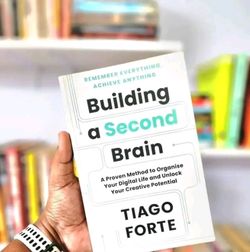
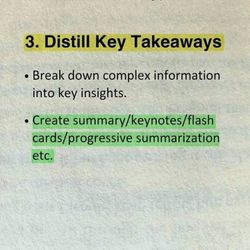
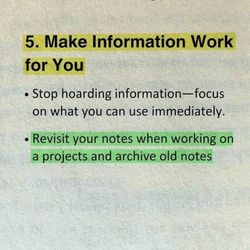
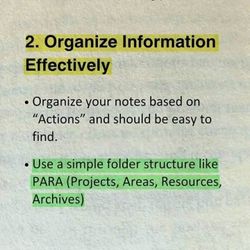
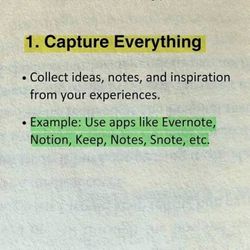
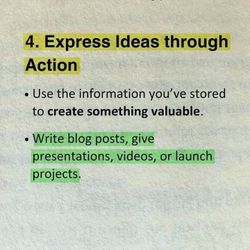
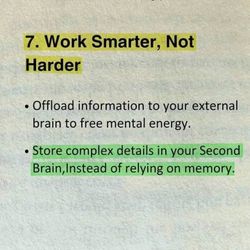
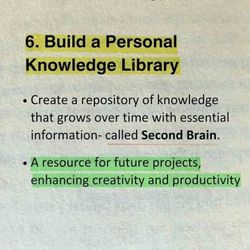
CODE: Capture, Organize, Distill, Express
CODE is argued to be a universal method for personal knowledge management (PKM). Forte encourages us to use digital technology to externalize our knowledge, research, and reflections overtime in a Second Brain. In doing so, our Second Brain frees our mind to do what we do best — create. Here’s how:
Capture: Keep what resonates. Draw inspiration from Richard Feynman’s 12 favourite problems if you don’t know what to capture.
Organize: Save for actionability. Use the PARA (Projects, Areas, Resources, Archives) method to categorize your notes. More on that later.
Distill: Find the essence. Practice the progressive summarization technique to help you identify the most valuable ideas from your notes.
Express: Show your work. What good is knowledge that is never shared? Use the intermediate packets contained within your Second Brain to assemble creative outputs quickly and effectively.
PARA: Projects, Areas, Resources, Archive
The PARA system proposes that all information in your Second Brain can be stored in one of four categories. These categories are ordered by actionability so that notes are resurfaced where they are most useful.
Projects: short-term efforts with a clear goal and timeline in mind (e.g., publish a novel, plan a vacation, deliver a presentation, etc.)
Areas: long-term responsibilities that matter to you (e.g., relationships, health, finances, etc.)
Resources: topics that interest you or might become useful in the future (e.g., world history, productivity, coffee, etc.)
Archive: anything that is no longer relevant from the previous three categories.
Concluding Thoughts
Tiago Forte refers to his Second Brain as a ‘knowledge garden’ that thrives when it is watered. By practicing the CODE framework in my own Second Brain, I can now draw unexpected connections between ideas and produce creative outputs that draw on my complete knowledge bank, as opposed to the individual ideas I can recall at a given time. However, unlike a real garden, I never have to worry that my knowledge garden will wilt if left unattended. I can rest assured that notes I have taken months or even years ago will be preserved for the next time I need them.
My one gripe with BASB is that PARA does not resonate with me. I appreciate having some separation between my work and personal life, so I will continue to organize my notebooks into topic-based categories such as Personal, Writing, Career, Learning, etc. That being said, I like the idea of archiving notebooks that are not currently relevant and will definitely be putting that into practice.
Over the past weeks and months, my Second Brain has become a valuable well of inspiration and creativity, enabling me to draw unexpected connections and produce innovative outputs. The overall impact on my creative process has been undeniable, and I am excited to continue cultivating my knowledge garden in the future.
Building a Second Brain (BASB)
In Building a Second Brain (BASB), productivity expert Tiago Forte proposes an elegant framework to organize your digital life. This framework, known as CODE (Capture, Organize, Distill, Express), blends the simplicity of a commonplace book with the versatility of modern technology. I finally had the opportunity to read BASB and reflect on what I had learned from Tiago Forte’s online content. Thus, I wanted to distill my key takeaways and express my final thoughts.
Building a Second Brain (BASB)
It’s 2024, and the burden of remembering every little detail should be a thing of the past.
You must give your mind a break to think freely and be creative. But how can you do that when there’s so much information overload? The knowledge that’s supposed to empower you is, instead, holding you back.
Whether you’re poring over your laptop at the workplace or mindlessly scrolling through social media at home, there’s a lot of information and data coming at you every second. No matter where the stimulus comes from, it eventually leads to information overload for your brain.
The remedy is to organize and manage information in a way that still keeps you productive. What if you could save your knowledge in a digital environment that you can access anytime?
You’d then need to hold only the most important information in your brain. Ergo, no more frazzled nerves and struggling to keep track of everything.
You can achieve this by building a second brain for personal knowledge management. It helps you retain all this crucial information in a digital space where you can head back whenever you want.
So, let’s understand how the BASB concept can change your life for the better.
What is Building a Second Brain?
Building a Second Brain (BASB), as conceptualized by Tiago Forte (one of the world’s foremost experts on productivity), is a systematic approach to creating a digital repository for organizing and taking action on the abundant ideas you come across daily.
Given the exponential growth in our online consumption, attempting to remember all this information becomes impractical. However, by consolidating this wealth of information in a single, accessible location, you’ll witness significant growth in your productivity.
Having a structured space for storing and organizing information allows our minds the freedom to think, imagine, and be present in the moment. Moreover, when not burdened by the constant pressure of trying to remember everything, you take the right actions.
C.O.D.E: Capture, Organize, Distill, Express
This four-step method helps you organize information and turn it into concrete results:
Capture: Gather information systematically from various sources, such as articles, videos, or other content. Using AI tools for note taking, capture relevant information and insights
Organize: Once information is captured, categorize and store it in a way that makes it easily accessible when needed
Distill: Extract the essential insights or key takeaways from the captured information
Express: Lastly, articulate and express the distilled information through note-taking, summarizing, or even creating content based on the insights gained
P.A.R.A: Projects, Areas, Resources, Archives
According to Forte, all the information in your life can be divided into just four categories:
Projects: This category is dedicated to the specific tasks or initiatives you are actively working on with all relevant information, tasks, and resources related to those projects. For example, your projects might include writing a report, planning an event, buying new furniture for your home, and learning to cook.
Areas: Areas represent broader aspects of your life or work that encompass long-term goals or responsibilities. For instance, work responsibilities like product management and coaching teams, and home responsibilities like home, kids, finances, etc.
Resources: This category is for valuable knowledge that may not be directly related to your project but relates to your areas of interests and might be useful in the future, such as reference materials, tools, or information. For example, information about personal finance, habit formation, growing herbs, wood-working, etc.
Archives: Archives store completed projects, outdated information, or anything that doesn’t require immediate attention but may be useful for future reference
Benefits of Using the BASB Method Benefit 1: No information overload
Building your second brain helps eliminate the stress that comes with the continuous consumption of information. But that’s not all; here are some more benefits of this proven method:
Benefit 1: No information overload
Have you ever felt incredibly overwhelmed by the sudden burst of information that you consume online? Let’s say in a week, you attend a series of webinars, read several articles on recent trends, and engage with online communities or discussions.
Your brain faces information overload and needs help organizing and categorizing information. This is where the second brain methodology can come in. If not, you will forget important details before you even realize it, and trying to connect the dots later is no fun!
By using modern tools like note-taking apps, virtual whiteboards, mind maps, and second brain apps, you can retain this information and communicate it effectively with your team. When you start collecting and jotting down the key learnings, you save yourself from drowning in irrelevant information and focus only on critical details.
Benefit 2: Effortless retrieval of knowledge
Let’s be honest; no one has the time to scour through details for the information they can use in strategic decision-making. That’s why you need the most important information at your fingertips.
For instance, imagine that you are preparing for a presentation, which is time-consuming and requires you to collect and represent a lot of information in fewer words. You are going through dozens of research articles, industry reports, digital notes from previous presentations, etc.
In such a stressful situation with much to collect and present, the BASB method helps you store the key points from your research in a digital workspace. When everything is stored in one place, you can save yourself from the hassle of context switching.
So summarize key points, use mind-mapping techniques to convey a compelling narrative, and jot down innovative ideas and angles as they arise during your research.
When the time comes, easily retrieve this information and create your final presentation without feeling you are missing something.
Benefit 3: Assists in creative ideation
When you have a constant flow of thoughts and inspirations, you must jot down ideas and thoughts as they arise quickly. Then organize them in relevant categories to avoid confusion when you return to them later.
The BASB method helps you create a central repository where you can store images, quotes, articles, or any other source of inspiration. You have something to refer to and act on when you face creative blocks.
It also allows you to combine different ideas, explore new possibilities, and provide space to experiment. The innovative and unique outcomes will then speak for themselves.
Also, consider using interactive whiteboard templates if you want a collaborative approach during ideation. These whiteboards will save you time as you and your team will all work in the same space without needing to share screens repeatedly. Easily connect and ideate together for the best results.
Benefit 4: Consistent project completion
Benefit 4: Consistent project completion
The BASB method helps you break down complex projects into manageable components, set milestones, and track progress consistently. It’s helpful, especially if you are working on different projects simultaneously.
Let’s say you are a project manager in a creative agency. Use your digital workspace to create detailed project plans and task lists, prioritize activities, and categorize them based on urgency. This will help you wrap up your tasks on time and in alignment with the requirements.
At the same time, use your second brain to document all project-related details, including decisions, challenges faced, and successful strategies employed. It becomes a valuable future reference and ensures a continuous learning process.
Also, if you’re worried about completing projects on time, try using second brain apps to keep everything on track and avoid delays.
Step 1: Identify your problems
The first step towards building a second brain is identifying your most common challenges. For instance, do you find it difficult to filter and retain valuable insights? Or is applying the consumed information a big hassle for you?
Keep questioning yourself about the areas where you find yourself stuck. Jot down these specific challenges to ensure you capture the required information and use the right approach to building a second brain.
For example, let’s say you struggle with creativity blocks. BASB helps you create a digital workspace to list all the brilliant ideas as they come to you. This way, you have something to get to when your mind goes blank.
Step 2: Capture the right information
Now you know the challenges you must face using a second brain. However, it is crucial to capture the right information, as not every information is equally valuable. That’s where a brainstorming session with the right ideation techniques helps you gather the right information.
It’s best to use diverse formats to capture information, such as notes, texts, images, links, audio recordings, and sketches.
If you want to incorporate brainstorming in the process of capturing information for your second brain, you should:
Create categories or themes for the types of information you want to capture
Identify actionable steps or tasks associated with the information you want to capture
Use an AI tool like ClickUp AI to generate tons of ideas around different topics. If you are planning on running a new campaign, brainstorm ideas. All you need to do is mention your ideas, and it’s done!
ClickUp AI can help with building a second brain efficiently
Use ClickUp AI as a prompt powerhouse to generate stunning AI art
Use the tool to summarize and store key information. For example, say you conducted a team meeting and have a transcript. The tool helps you summarize it for future reference.
ClickUp AI
Use ClickUp AI to draft, edit, and summarize content in a matter of seconds
Use tags and keywords during brainstorming to identify key themes and concepts
Use visual tools such as mind maps, diagrams, or concept maps
Refine your ideas and capture information as your second brain evolves
In addition, develop a habit of capturing information as you encounter it. Whether through note-taking apps, voice memos, or bookmarking tools, capture anything relevant to your interests and work.
If you still need more help with brainstorming, try using brainstorming software to ensure you never run out of ideas again.
Step 3: Choose the right tools and technology
Building a second brain is about organizing, categorizing, and retrieving information when needed. While you can spend hours manually tackling these tasks, investing in knowledge management software will make your job easier.
Using the right technology, you can even access your second brain on the go, on multiple devices. Store information in a way that is easily understandable when you access it after a while. For instance, ClickUp Docs come with many different styling options, formats, etc., to collect and present your information.
ClickUp Docs GIF
Use ClickUp’s Docs to create and connect beautiful documents, wikis, and more for seamless idea execution with your team
Different teams can easily collaborate on the doc and brainstorm together. Create a second brain that keeps everything intact for everyone. Editing in real time helps ensure that important ideas are not missed during discussions.
Connect ClickUp Docs to Workflows for building a second brain
Connect ClickUp Docs to your workflow by linking tasks together
ClickUp Whiteboards help you take your brainstorming to the next level. This kind of visual collaboration is particularly helpful for remote or hybrid teams. Combining this with the right brainstorming templates allows you to have some great ideation sessions with your team.
ClickUp Whiteboard
ClickUp offers the world’s only virtual whiteboard that turns your team’s ideas into coordinated actions—all in one place.
Lastly, organizing information is crucial to building a second brain. Easily categorize these docs and add them wherever they fit in your workspace for quick reference.
Step 4: Create an organizational structure
You must develop an organizational structure for your second brain (C.O.D.E and P.A.R.A). You already have different pieces of information that demand a hierarchy reflecting their relationship.
That’s where AI tools for mind mapping, such as ClickUp Mind Maps, help you visualize your ideas and draw connections between tasks and ideas. The simple drag-and-drop feature allows you to modify your existing workflows.
ClickUp's Mind maps
Plan and organize projects, ideas, or existing tasks with ClickUp Mind Maps.
And the best part? Create, edit, or delete tasks directly from your mind map without switching to other views. Such visual representations ensure you create a second brain that helps you retain information and take action when necessary.
Step 5: Schedule reviews
Building a second brain is not a one-time process. You must set aside time to revisit your notes, assess new information, and refine your organization. This ensures that your second brain remains relevant and accurate, and continues to evolve alongside your thoughts and projects.
Set aside weekly reviews for one hour or so. During the review process, focus on the following:
Scan through the overall structure of your second brain
Check for any major updates or changes in your projects or focus areas
Review notes and entries made during the past week
Ensure that new information is properly categorized and linked within the system
Take a moment to reflect on any insights or connections you’ve discovered
Check the status of tasks and projects
Update any deadlines, priorities, or completed tasks
While weekly reviews are fruitful, you should also schedule a monthly deep dive where you can:
Identify overarching themes or patterns that have emerged over the past month
Consider how these themes connect to your long-term goals
Reflect on areas where your second brain may be lacking information
Plan for targeted research or note-taking to fill these gaps
Assess the effectiveness of your current tools and technologies
Explore new features or platforms that may enhance your second brain experience
Based on these reviews, distill insights and identify the trends, connections, and patterns that emerge over time. This will enhance your overall decision-making and creative capabilities.
By undefined
25 notes ・ 28 views
English
Intermediate